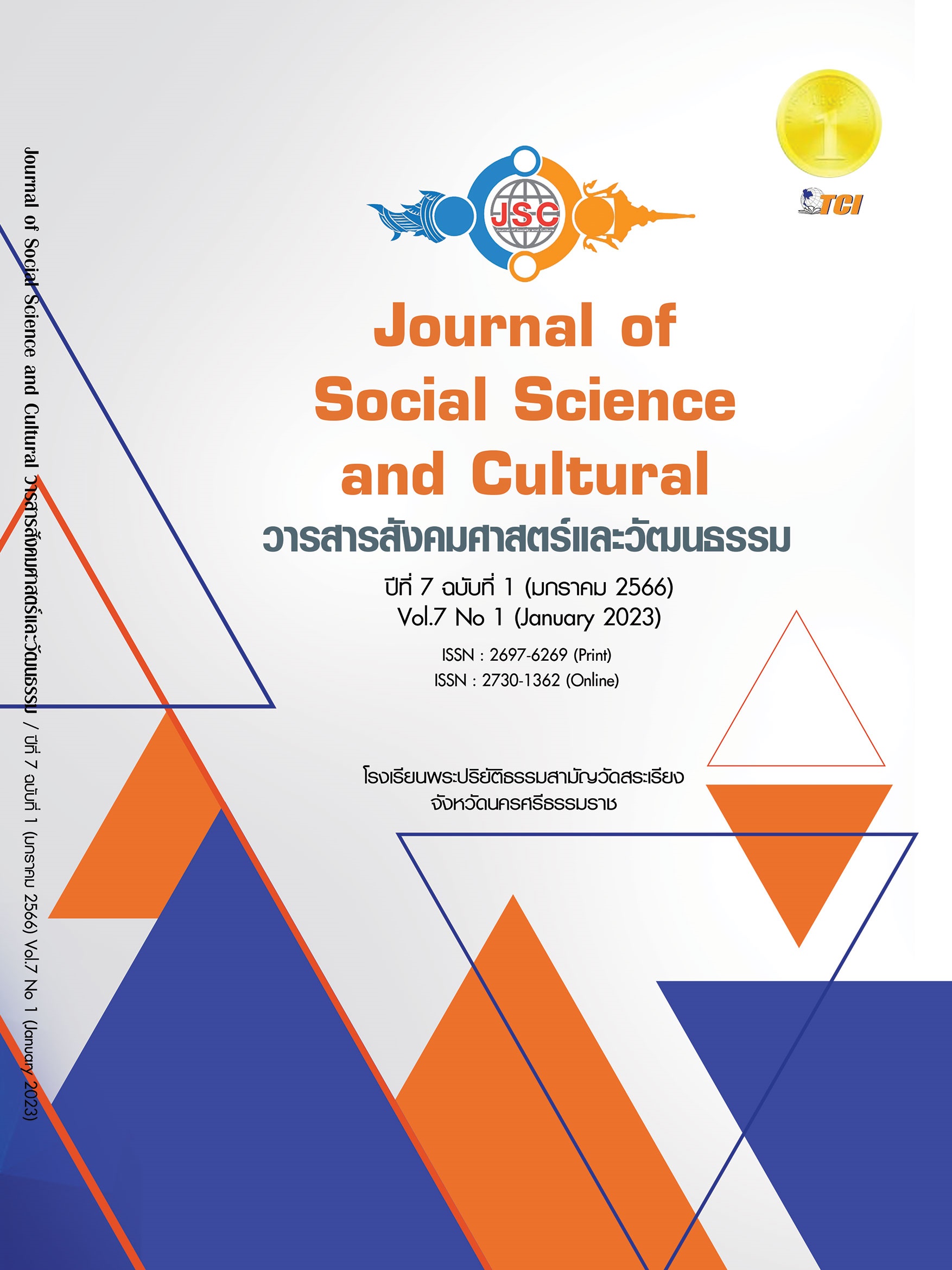THE LANGUAGE THAT REFLECTS THE CULTURE OF CHANTING PHRA MALAI OF THE VAREE HOUSE, PANYAPIWONG, SURAT THANI PROVINCE
Main Article Content
Abstract
The objective of this research article is to analyze the language that reflects the culture of chanting Phra Malai of the Varee House, Panyapiwong, Surat Thani Province. It uses a qualitative research method by collecting data from documents, VDOs, in-depth interviews, field information at funerals and public and private events, as well as field observations. The main informants were 4 people who chanted Phra Malai as the source of the sound or the mother of the song. Use the method of selecting specific informants. and presented the results of data by descriptive analytical method. The findings showed that there were 4 aspects of language that reflected culture: firstly, language that reflects belief culture is Buddhist beliefs and superstition beliefs. Secondly, language reflects the culture of local wisdom, including natural living, transportation, house architecture, tools, time signs, costumes, musical instruments, and funeral rituals. Thirdly, language reflects the linguistic culture that appears in the Phra Malai script, including idioms, the use of pronouns, speaking indirectly, local dialects, and Pali. Fourthly, language that reflects the culture of values, such as women reserving themselves and women's beauty values. This research, therefore, reflects that chanting Phra Malai for both giving morals and entertainment is also an important tool in reflecting the culture of beliefs, way of life, wisdom, and values that are valuable to society.
Article Details
References
กาญจนา แก้วเทพ. (2548). ขับกลั่น คัดกรอง ตรองดู: สื่อพื้นบ้านสื่อสารสุข. กรุงเทพมหานคร: โครงการสื่อพื้นบ้านสื่อสารสุข (สพส.).
จำนงค์ ทองประเสริฐ. (2519). ภาษาของเรา. กรุงเทพมหานคร: แพร่พิทยา.
ชฎาลักษณ์ สรรพานิช. (2524). ศึกษาเรื่องพระมาลัย: การศึกษาเชิงวิเคราะห์. ใน วิทยานิพนธ์ศิลปศาสตรมหาบัณฑิต สาขาจารึกภาษาไทย. มหาวิทยาลัยศิลปากร.
ธวัช ปุณโณทก. (2525). วรรณกรรมท้องถิ่น. กรุงเทพมหานคร: โอเดียนสโตร์.
ปรมินท์ จารุวร. (2553). พลวัตของการสวดอ่านวรรณกรรมเรื่องพระมาลัย: การศึกษาเปรียบเทียบการสวดพระมาลัยที่จังหวัดกาญจนบุรีและชลบุรี. กรุงเทพมหานคร: จุฬาลงกรณ์มหาวิทยาลัย.
พระอุดมธีรคุณ (ภาวัต) วิสุทเธสโก (แสวงดี) และบัณฑิกา จารุมา. (2563). ภาษาและวัฒนธรรม : ความหมาย ความสำคัญ และความสัมพันธ์ระหว่างกัน. วารสารมหาจุฬาวิชาการ, 7(2), 53-63.
ภัครพล แสงเงิน. (2562). ลักษณะสำคัญของพระมาไลย ฉบับหอสมดุแห่งชาติกรงุปารีส. วารสารมนุษยศาสตร์วิชาการ, 26(2), 285-315.
วัฒนา ณ นคร. (2526). ศึกษาเรื่องลักษณะร่วมของเรื่องพระมาลัยในวรรณกรรมพื้นบ้านและพระมาลัยคำหลวง. ใน วิทยานิพนธ์อักษรศาสตรมหาบัณฑิต สาขาวรรณคดีเปรียบเทียบ. จุฬาลงกรณ์มหาวิทยาลัย.
สุธิวงศ์ พงศ์ไพบูลย์. (2525). วัฒนธรรมพื้นบ้าน: แนวปฏิบัติในภาคใต้. กรุงเทพมหานคร: สถาบันทักษิณคดีศึกษา มหาวิทยาลัยศรีนครินทรวิโรฒ สงขลา.
อนันต์ อารีย์พงศ์. (2556). วรรณกรรมพระมาลัย: สารัตถะและการสืบทอด. กรุงเทพมหานคร: นพเก้าการพิมพ์.
อร่ามรัศมิ์ ด้วงชนะ. (2538). การศึกษาประเพณีสวดพระมาลัยของชาวอำเภอไชยา จังหวัดสุราษฎร์ธานี. ใน วิทยนิพนธ์ศิลปศาสตร์มหาบัณฑิต สาขาวิชาไทยคดีศึกษา. มหาวิทยาลัยทักษิณ.
อุดมพร คัมภิรานนท์. (2551). ศึกษาเรื่องการศึกษาหลักธรรมทางพระพุทธศาสนาที่ปรากฏในเรื่องพระมาลัยคำหลวง. ใน วิทยานิพนธ์พุทธศาสตรมหาบัณฑิต สาขาวิชาพระพุทธศาสนา. มหาจุฬาลงกรณราชวิทยาลัย.


